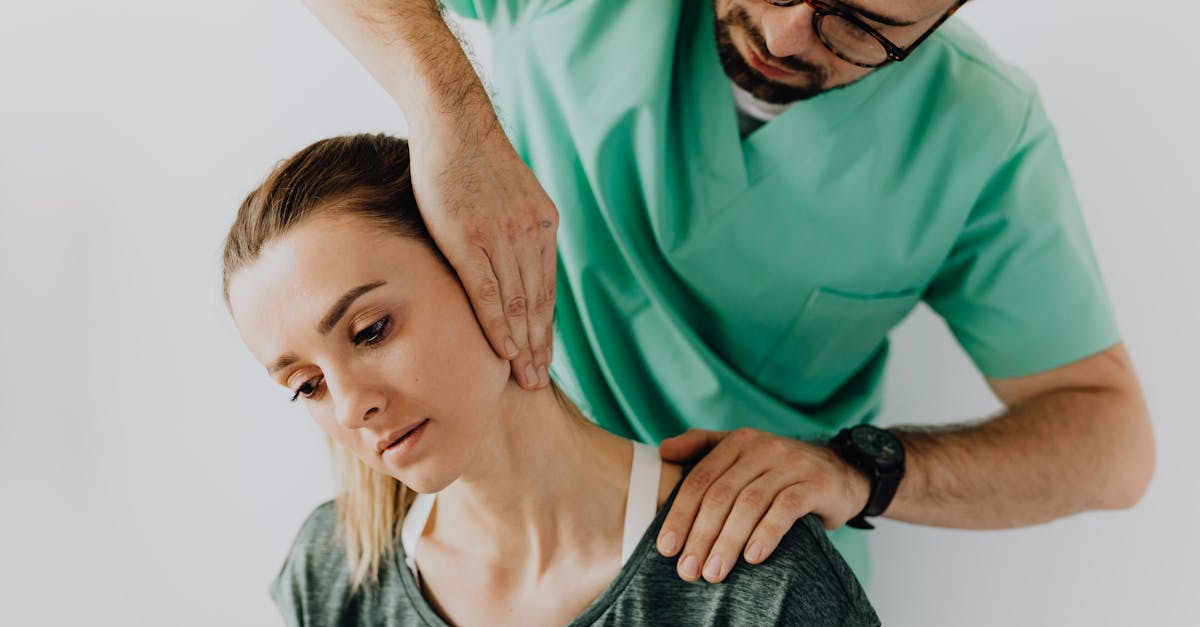In Short, simple exercises to relieve neck and shoulder pain are practical movements designed to alleviate discomfort caused by muscle tension and stress. These exercises aim to enhance flexibility and circulation, offering effective relief to individuals suffering from persistent tightness. By incorporating techniques such as neck stretches, shoulder rolls, and chest expansions, one can experience reduced pain and improved posture. Regular practice of these movements not only helps in soothing pain but also contributes to overall well-being, making it a vital part of daily routine for those looking to combat neck and shoulder discomfort. |
Neck and shoulder pain is a common ailment that can stem from poor posture, stress, and muscle tension. To alleviate discomfort, incorporating simple exercises into your daily routine is essential. Stretches like the neck release, shoulder circles, and wide shoulder stretch can help restore mobility and ease tension. Additionally, performing side-to-side bends and chest expansions aids in promoting blood circulation, which is vital for recovery. Regular practice of these exercises not only enhances flexibility but also plays a significant role in maintaining overall musculoskeletal health.

Welcome to Pulse Align, where our innovative approach facilitates the body’s journey back to its natural balance and optimal posture. Through gentle and imperceptible pulses, we create an environment that promotes proper muscle tone symmetry and encourages the body to release any built-up tension and discomfort.
Restoring Natural Balance
At Pulse Align, we’re dedicated to helping our clients achieve a state of *well-being* without focusing on specific discomforts or conditions. Our approach nurtures the body’s inherent ability to recalibrate itself naturally, which often translates into enhanced comfort and improved posture. By fostering a supportive environment, our clients frequently report feeling more aligned and at ease in their daily activities.
Personalized Care for Everyone
We understand that every individual has unique needs, which is why our personalized approach at Pulse Align emphasizes listening to our clients and tailoring experiences to foster overall *wellness*. Many clients have shared transformative experiences, noting significant improvements in their postural balance, muscle tension, and overall comfort. We’re proud to welcome *families*, including children and pregnant women, to explore the benefits of our services together.
Book Your Journey with Pulse Align
We invite you to visit our website at Pulse Align to learn more about our services and to discover convenient locations near you. Whether you’re in La Prairie, Mont-Royal, or Terrebonne, our clinics create a welcoming atmosphere for you and your family. We encourage you to book your consultation today and experience our *safe, non-invasive approach* that complements your journey to wellness while remaining under the guidance of your healthcare team.
Remember, Pulse Align works alongside, not in place of, healthcare services. We’re excited to support you in restoring balance and enhancing your overall wellness experience.
- Across-the-chest stretch
- Neck release
- Chest expansion
- Eagle arms spinal rolls
- Seated twist
- Shoulder circles
- Doorway stretch
- Side-to-side bends
- Head lifts
- Upper trapezius stretch

Experiencing discomfort in the neck and shoulders is a common issue that many individuals face, especially in today’s fast-paced, sedentary lifestyles. Fortunately, incorporating simple exercises into your daily routine can lead to significant relief. This article explores various stretches and movements aimed at alleviating neck and shoulder pain, promoting better posture and overall muscle health.
Essential Stretches for Neck Relief
Wide Shoulder Stretch
Begin by standing tall with your feet shoulder-width apart. Take a deep breath, and as you exhale, extend your arms wide to the sides, feeling the stretch across your chest and shoulders. Hold this position for about 15-30 seconds. This simple yet effective stretch can alleviate tightness in the shoulder muscles and enhance blood circulation.
Neck Release
For this exercise, gently tilt your head to one side, bringing your ear toward your shoulder while ensuring your shoulders remain relaxed. You can intensify the stretch by using your hand to apply light pressure on the opposite side of your head. Hold for 15-30 seconds on each side. This motion aids in releasing tension built up in the neck muscles.
Dynamic Movements for Shoulder Mobility
Shoulder Circles
Shoulder circles are a restorative exercise that promotes mobility in the shoulder joints. Stand or sit upright and start rolling your shoulders forward in a circular motion. After 10-15 repetitions, switch directions and roll them backward. This simple movement can enhance flexibility and reduce stiffness.
Eagle Arms Spinal Rolls
To perform eagle arms, extend your arms in front of you and cross them over each other, tucking one arm under the other. Lift your elbows while pressing your hands together. Hold this position for a few seconds, and then release. Following this, gently roll your spine forward and back to further stretch and mobilize the upper back and shoulders.
Integrating Routine Stretching
Seated Twist
This twist can be performed while seated at your desk, making it an ideal exercise for the workplace. Sit up straight and place your right hand on the back of your chair. Gently twist your body to the right, using your left hand for support while keeping your shoulders relaxed. Hold for 15-30 seconds and then switch sides. This stretch will help in relieving tension throughout your back and neck.
Doorway Stretch
Stand in a doorway and place your forearms on the doorframe, leaning slightly forward until you feel a stretch in your chest and shoulders. This stretch opens up the front of your body and helps to counteract the rounded shoulder posture that results from prolonged sitting. Hold for 15-30 seconds for optimal benefit.
Cultivating a Holistic Approach
Incorporating these simple exercises into your daily routine can greatly diminish discomfort linked to neck and shoulder pain. It is vital to remain consistent with your routine while being mindful of posture throughout your daily activities. The ultimate goal is to harmonize your movements with your body’s needs, enhancing neuromuscular health and promoting natural alignment.
The journey towards alleviating muscle tension and discomfort is ongoing, and it requires a comprehensive understanding of your body’s mechanics. By embracing these practical exercises and prioritizing a balanced lifestyle, you can foster an environment conducive to recovery and well-being.
| Exercise | Description |
| Across-the-chest stretch | Helps improve flexibility and reduce tightness in the shoulders. |
| Neck release | Alleviates neck strain by gently stretching the muscles. |
| Shoulder circles | Enhances mobility while easing any tension in the shoulders. |
| Seated twist | Improves spinal flexibility and helps release built-up pressure. |
| Chest expansion | Stretches the chest, promoting better posture and reducing neck strain. |
| Eagle arms spinal rolls | Combines upper body stretching with spinal mobility, enhancing overall comfort. |
| Doorway stretch | Stretches the chest and shoulders, offering relief from upper body tightness. |
| Side-to-side bends | Target the neck muscles while enhancing range of motion. |
| Forward and backward bends | Helps in loosening and relaxing the neck area effectively. |
| Levator scapulae stretch | Specifically targets the muscle that connects the neck and shoulder. |

The Wellness Journey: Client Experiences with Pulse Align
Many clients have discovered the benefits of Simple Exercises to Relieve Neck and Shoulder Pain through their journey at Pulse Align. They particularly appreciate how our unique approach supports the body’s natural ability to recalibrate and restore balance, which is essential for holistic recovery. Our dedicated team emphasizes natural methods that align with the body’s innate healing capabilities.
For instance, clients from Les Escoumins have reported significant relief after integrating these exercises into their daily routine. They have found that consistent practice not only alleviates physical discomfort but also fosters a profound sense of overall well-being. The personal testimonials highlight the transformation they experience, attributing a revitalized lifestyle to the focused strategies provided by Pulse Align.
Similarly, in the vibrant community of Mont-Royal, individuals seeking to enhance their body function have shared stories of improved mobility and decreased pain levels. This city’s residents value how our services effectively support their wellness goals, showcasing a commitment to natural health solutions that work in harmony with their bodies.
Clients in Chicoutimi have also reflected on how they have felt improvements naturally following our guidance on neck and shoulder relief exercises. Their success stories underscore a growing appreciation for wellness practices that are both simple and effective, proving that taking a step towards holistic health can lead to tangible results.
Whether in Charlesbourg or Deux-Montagnes, Pulse Align is collaborating with healthcare teams to ensure that clients and their families embark on a wellness journey rooted in support and understanding. Our mission is to facilitate a path where every individual feels empowered to reclaim their health, naturally.
For those in Panama City or Saint-Jérôme, exploring our holistic recovery options could provide the relief and balance you seek. Our clinics are strategically located for clients in these regions to easily access our dedicated services aimed at enhancing well-being.
Empowering our clients to take control of their health is truly rewarding, and we at Pulse Align are committed to guiding you through your wellness journey. Discover the possibilities by visiting Our Clinics.
Experiencing neck and shoulder pain can be a debilitating issue that affects many individuals, particularly in today’s fast-paced world. The combination of prolonged periods spent at desks, looking at screens, or engaging in repetitive motions can contribute significantly to discomfort in these areas. Fortunately, integrating simple yet effective exercises into daily routines can dramatically alleviate tension and enhance mobility, fostering a healthier lifestyle.
According to Dr. Sylvain Desforges, an accomplished expert in osteopathy, naturopathy, and manual medicine, targeting the neck and shoulder regions with appropriate exercises is instrumental in addressing chronic pain management. With the establishment of TAGMED clinics and the ACMA association, he emphasizes the necessity of a holistic approach toward healthcare innovation. Dr. Desforges believes that evidence-based care combined with physical activities can optimize patients’ health and well-being.
One effective method to relieve neck and shoulder pain is through consistent stretching exercises. A few recommended stretches include the across-the-chest stretch, where you draw one arm across your body, holding it with the opposite hand. This encourages a good range of motion and flexibility in the shoulder joint, alleviating tightness.
Another beneficial stretch is the neck release, involving gentle lateral movements of the head. By slowly tilting the head towards each shoulder, individuals can release built-up tension in the neck muscles, making this exercise a practical and simple solution for everyday use.
The chest expansion stretch is also vital, where one can clasp their hands behind their back and draw their shoulders back, opening up the chest area. This counteracts the hunched posture often adopted while using computers or smartphones, effectively improving posture and reducing pain.
Moving to more dynamic exercises, the shoulder circles exercise is an excellent choice. By raising the arms and moving them in circular motions both forwards and backwards, this activity promotes blood circulation and helps diminish stiffness surrounding the shoulder girdle.
Furthermore, exercises such as the eagle arms spinal rolls and seated twists can provide significant relief. The eagle arms focus on stretching the upper back and shoulders, whereas seated twists target the spine and help relieve any extra tension accumulated through poor posture.
Additionally, integrating doorway stretches can be beneficial. Standing in an open doorway and placing your arms on the frame while leaning forward gives a great stretch to the chest and shoulders, crucial in counteracting the effects of prolonged sitting.
Subsequently, Dr. Desforges champions the importance of regular practice of these exercises, indicating that consistency is key to achieving long-term improvements. He acknowledges the role of technologies such as spinal decompression and shockwave therapy in conjunction with movement-based interventions, asserting that they help to maximize patient recovery and well-being.
In summary, with the right blend of exercises, individuals grappling with neck and shoulder pain can discover relief and reconnection with their bodies. Consultation with healthcare professionals, like Dr. Sylvain Desforges, not only provides access to effective treatment options but also fosters an understanding of personalized care. Simple exercises are not just remedies; they are proactive steps toward better overall health.
Mechanism of Action
The neurovertebral decompression technology provided by TAGMED employs a controlled and progressive traction force on the spine. This method effectively increases the space between vertebrae, alleviating pressure on intervertebral discs and nerve roots. By creating a negative pressure environment within the discs, this approach facilitates the retraction of herniated or bulging discs, allowing them to return to their proper positioning. Additionally, it enhances fluid circulation within the targeted area, promoting nutrient exchange and waste removal. This process significantly contributes to reducing inflammation and relieving pain symptoms associated with conditions such as disc herniation and spinal stenosis.
Specific Benefits
This non-invasive method is designed to effectively relieve chronic pain and symptoms associated with conditions discussed in “Simple Exercises to Relieve Neck and Shoulder Pain.” By significantly reducing pressure on nervous structures and optimizing fluid circulation around the discs, TAGMED’s neurovertebral decompression promotes faster recovery times and enhances the overall quality of life for a broad spectrum of patients. The painless nature of this treatment makes it a favorable alternative for individuals seeking lasting relief from chronic discomfort without the drawbacks of more invasive procedures.
Comparison with Other Treatments
When comparing TAGMED’s neurovertebral decompression technology to other commonly employed therapeutic approaches like analgesics, corticosteroid injections, surgery, or traditional physiotherapy, several unique advantages emerge. Unlike medications that may present risks of dependence or side effects, neurovertebral decompression is an entirely non-invasive treatment. Additionally, its efficacy in decreasing pain can lead to more rapid recovery, allowing patients to return to their daily activities sooner than with recovery from surgical procedures or ongoing medication management. Furthermore, the reduced risks associated with invasive interventions solidify the case for considering neurovertebral decompression as a primary treatment option.
Case Studies or Testimonials
Numerous patients have reported substantial benefits from TAGMED’s neurovertebral decompression in managing their chronic pain and related symptoms. For instance, one patient who had struggled with severe neck pain attributed to a herniated disc experienced a >50% reduction in pain within a few sessions. Testimonies highlight improvements such as prolonged periods of pain relief, quicker returns to daily activities, and decreased reliance on pharmacological treatments. These personal experiences underscore the effectiveness of neurovertebral decompression and exemplify its promising role in chronic pain management.
Finding Relief Through Simple Exercises
In today’s fast-paced world, the prevalence of neck and shoulder pain has become a common affliction. Many individuals experience discomfort due to long hours spent hunched over computers or engaged in repetitive movements. Fortunately, incorporating simple exercises into your daily routine can significantly alleviate this pain.
Exercises such as the across-the-chest stretch and neck release are effective for improving flexibility and reducing tension. These stretches do not require extensive time or equipment, making them accessible for anyone, even in the workplace. A few minutes spent practicing these movements can keep discomfort at bay and foster better posture.
Moreover, engaging in movements like shoulder circles and eagle arms spinal rolls encourages blood flow to the affected areas. This increased circulation can help mitigate stiffness while promoting a sense of relaxation. Such simple routines can be seamlessly integrated into your breaks, offering instant relief from the stress of the day.
It’s essential to note that maintaining proper posture is crucial in preventing recurring pain. Regularly performing stretches at your desk can act as a preventative measure against the strain that accumulates throughout the workday. The combination of awareness and exercise can lead to a more profound understanding of one’s body, enabling individuals to detect pain earlier and address it effectively.
Ultimately, focusing on simple exercises to relieve neck and shoulder pain can empower individuals to take control of their wellbeing. By dedicating time to stretch and strengthen these areas, practitioners can foster a healthier lifestyle while combating discomfort. Embracing these strategies may not only enhance physical health but also contribute positively to mental wellbeing.

Do you suffer from a chronic condition that responds little or not at all to conservative treatments?
Pulse Align offers an innovative approach to achieving the body’s natural balance and improved posture through gentle, imperceptible pulses. This non-invasive method is designed to foster the body’s ability to recalibrate itself, which can lead to enhanced comfort and reduced tension in the muscles and joints. Rather than focusing on discomfort directly, the emphasis is on supporting overall well-being through restoration of symmetry in muscle tone.
At Pulse Align, the goal is not to treat symptoms but to assist the body in its natural process of recalibration. Clients often experience remarkable improvements in their overall wellness, leading to better posture and a more balanced physical state. The gentle stimulation provided at Pulse Align encourages the body to respond positively, showcasing that many benefits can arise when the focus is shifted away from specific discomforts and towards holistic well-being.
What sets Pulse Align apart is its personalized approach. Numerous testimonials highlight the positive experiences of clients who have noticed significant improvements in their overall wellness, including reductions in neck and back tension. Clients have reported feeling lighter, more balanced, and more in tune with their bodies after utilizing our services. This is an approach grounded in understanding, compassion, and respect for each client’s unique journey towards wellness.
For those interested in exploring how Pulse Align can become part of their wellness journey, we encourage visiting our website to learn more. Find nearby locations in cities such as La Prairie, Mont-Royal, and Terrebonne, and book a consultation for yourself or your family. Remember that Pulse Align works alongside your existing healthcare services, amplifying their efforts without replacing them. Our approach is safe, non-invasive, and suitable for the whole family, including young children and pregnant women.
To learn more about our services and book an appointment, visit our website: Pulse Align.
Frequently Asked Questions
Headache and Migraine
Are migraines hereditary?
Yes, the predisposition to migraines can be genetic, making some people more susceptible.
Does exercise help regulate migraines?
Moderate, regular exercise reduces stress and improves circulation, potentially lowering migraine frequency.
Do strong smells trigger migraines?
Yes, certain strong odors (perfume, solvents) can provoke or worsen attacks.
Do certain foods trigger migraines?
Some foods (chocolate, aged cheese, alcohol, MSG) can trigger attacks in predisposed individuals.
How to differentiate a migraine from a tension headache?
Tension headaches cause diffuse, moderate pressure. Migraines are often more severe, pulsating, one-sided, and accompanied by associated symptoms.
When should I see a doctor for headaches?
If headaches are frequent, intense, accompanied by unusual symptoms, or disturb your daily life.
Can identifying triggers reduce migraines?
Yes, keeping a headache diary helps identify triggers so you can avoid them.
Can lack of sleep cause migraines?
Yes, insufficient or poor-quality sleep is a common migraine trigger.
Do migraines decrease after menopause?
Often, migraine frequency reduces after menopause due to hormonal stability, but not always.
Does regular hydration prevent headaches?
Yes, staying hydrated reduces the risk of dehydration-related headaches.
Ethan Dubois is dedicated to shining a light on the hidden struggles of chronic headaches. As a Headache Awareness Advocate at Pulse Align, he combines compassionate storytelling with cutting-edge research to bring clarity, comfort, and hope to those affected. Ethan’s mission is to empower readers with knowledge, break through stigma, and foster a supportive community where every voice is heard. When he’s not crafting insightful articles, Ethan can be found exploring the latest wellness trends, sharing practical coping strategies, or simply lending a listening ear to those in need. His heartfelt approach and unwavering commitment to awareness make him a trusted ally for anyone navigating life with headaches.




